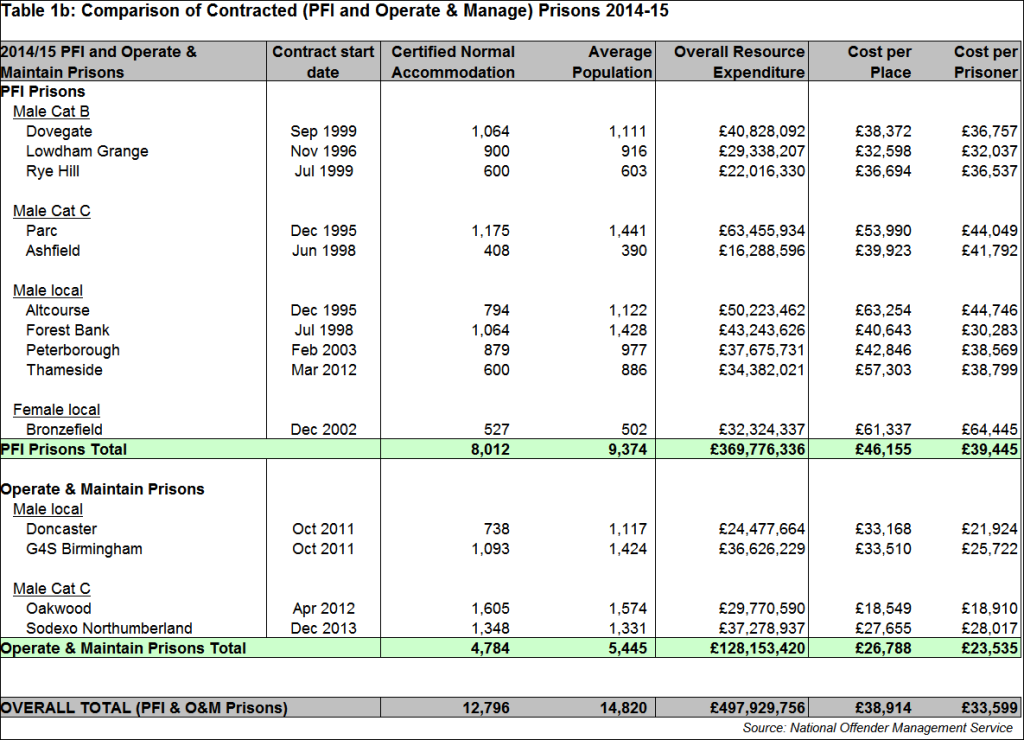Are private prisons cheaper?
Given the recent announcement that the government plans to build nine new prisons and the presumption that these will be privately built and run, I thought it was timely to re-visit the discussion of how the costs of publicly- and privately-run prisons compare.
The last Justice Secretary, Chris Grayling, talked regularly about how much cheaper private prisons are. This appears to be a commonly held view, with most commentators attributing it to a range of reasons:
- Most private prisons are new builds and do not require the same level of upkeep as antiquated Victorian jails.
- They are designed to be efficient and to be operated by fewer staff.
- They are often very large indeed (the new “Titan” prison being built in Wrexham will house 2,000 prisoners), bringing economies of scale.
- Private operators have more modern working practices and/or less generous wage levels.
[divider]
Latest official costs
On 29 October 2015, the MoJ published the latest costs per place and costs per prisoner for 2014-15 in the NOMS Annual Report and Accounts (management information addendum).
The MoJ makes it clear that public sector & private sector costs are not directly comparable because of “differences in accounting treatment and scope of service”. In practice, this is because of two main factors:
- Public Finance Initiative (PFI – new build privately run) prisons include a charge for interest on capital
- Most private sector prisons include healthcare costs in their charges
Here’s the official summary:
As you can see the annual cost of keeping an average of 84,238 people in prison in 2014/15 was £2.8 billion.
The cost per prison place was £3,182 (8.9%) dearer in the private sector.
The cost per prisoner was £373 (1%) more in the private sector.
Once you factor in healthcare costs, it’s probably fair to say that private sector prisons are slightly cheaper, although nowhere near as much as politicians would have us believe.
[divider]
Wide range in costs of private prisons
Perhaps even more interesting is the different costs per prisoner between various private prisons. Again, here’s the official data:
When we compare like with like, we unearth some intriguing findings, but no clear pattern.
The largest PFI male local prison, Forest Bank (Sodexo) does have the cheapest cost per prisoner at £30,283. However, the second largest, Altcourse (G4S) has the dearest at £44,746 – 48% dearer. Both prison contracts started over 15 years ago.
The cost per prisoner place in the three Category B male PFI prisons (again, all these contracts have been running since the mid-late 1990s) varies between £32,037 (Lowdham Grange, run by Serco) and £36,757 (Dovegate, also a Serco prison). Both prisons were the object of unannounced inspections this year and both were found to have worryingly high levels of violence.
Again, the cost per prisoner in the similarly sized male Category C prisons which are run privately (but were not PFI new builds) varied hugely from £18,910 at Oakwood (operated by G4S) to £28,017 at Northumberland (operated by Sodexo).
So Sodexo operates the cheapest PFI male local but the dearest (already existing) male category C prison.
[divider]
Central costs
Another interesting fact to be found in the “supplementary data” section of the NOMS accounts is the very large proportion of overall prison costs incurred by NOMS itself – “HQ overheads” are listed as £357.8 million (13%) of the total budget and “Regional overheads” as £89.3m (a further 3%).
[divider]
Conclusion
Once Michael Gove publishes more details of the nine new prisons he intends to build and we know for sure that they will be PFI, we can start testing out the Chancellor’s claim that the prison estate will be £80 million a year cheaper to run.











4 Responses
Well done Russell, in trying to tackle this very technical issue of cost.
In my book, ‘Competition for prisons: public or private?’, published later this month by The Policy Press, I look at all the available data and the many issues surrounding cost. Besides the ones Russell mentions:
1) there’s a difference between prisons transferred to the private sector after market testing, where TUPE applies, therefore importing public sector costs into the private sector to some extent, and new builds like Oakwood where the private sector can choose their own Ts and Cs
2) other adjustments are needed to ensure fair comparisons e.g. the private sector pay insurance, the public sector do not, Treasury just pick up the bill
3) the public sector has reformed its pay and pension schemes but the effect of these changes won’t be fully seen for decades
4) few who are familiar with pension schemes think the costs of the public sector scheme really is met by current contribution rates
5) you have to take account of other factors eg Oakwood is cheaper in part because just much bigger than any public sector comparator
and so on.
My own view, based on a range of data, is that there remain a large cost difference, the private sector being considerably cheaper. Of course, ‘cheaper’ can mean ‘unsafe’ – though nowadays, that may apply in either sector, as the Chief Inspector has commented.)
But perhaps the most important point is the lack of adequate public information: although privately run prisons have been around for 25 years, there is almost nothing in the public domain comparing costs properly (and what there is , is 20 years old). And cost matters. With money tighter than ever, we the public ought to know – and for that matter, Government itself ought to know – the true comparative costs of the two sectors. And particularly when decisions are about to be made on future investment.
Thanks Julian. I knew that I didn’t have the skills to do a proper comparison so it’s extremely helpful to have your expert input.
As you say, it would be good to have more transparent information.
Please let me know when your new book is published.
Russell thanks, published next week.
Russell thanks, published next week. Actually I am not convinced NOMS istelf understands the comparative costs correctly!